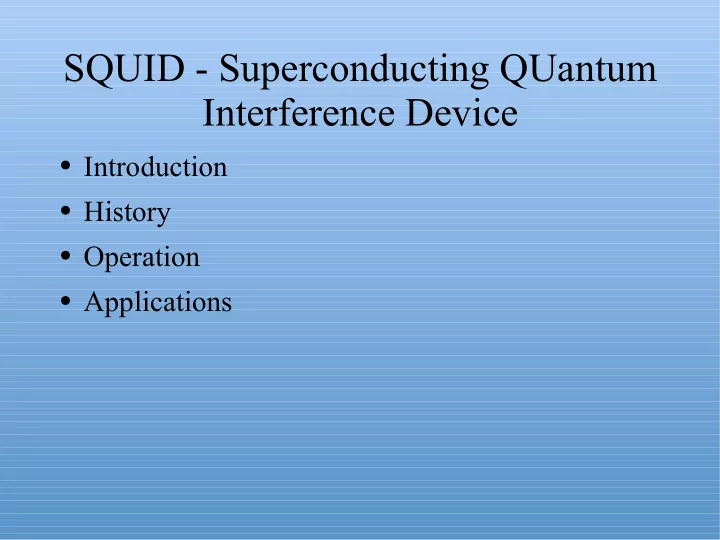

SQUID - Superconducting QUantum Interference Device ● Introduction ● History ● Operation ● Applications
Introduction ● Very sensitive magnetometer ● Superconducting quantum interference device – based on quantum effects in superconducting loop ● Useful for many purposes in physics, biology and medicine
History ● 1962: British physicist Brian David Josephson discovers Josephson effect, invents Josephson junction, SQUID ● 1973 Nobel Prize (with Leo Esaki and Ivar Giaever) http://www.tcm.phy.cam.ac.uk/~bdj10/
Operation – Josephson effect ● The Josephson effect occurs when an electric current (Cooper pairs) flows between two superconductors separated by a thin non- superconducting layer through quantum tunnelling. Junction is called a Josephson junction. Can only support a certain maximum (critical) current in a superconducting state. http://www.albanet.com.mx/articulos/josephson.gif (modified)
Operation – Josephson junctions ● Types of Josephson Josephson junction junctions: – Tunnel junctions, barrier is an oxide insulator – Semiconductor junctions – Dayem bridge junctions, based on a constriction. http://cr.physics.ed.ynu.ac.jp/labs/magne/shimazu/031101/results.html
Operation – Superconducting loop ● A SQUID consists of a loop of superconductor with one or more Josephson junctions, called weak links. ● Inner diameter of loop ~ 100 µ m.. ● Generally made from either an alloy of lead and gold or indium, or pure niobium. ● Ceramic superconductors such as yttrium-barium- copper-oxide also possible, but difficult to manufacture.
Operation – DC SQUID ● Current made to flow around the loop through both Josephson junctions. ● Electrons tunnel through the junctions, interfere. ● Magnetic field through the loop causes a phase difference between electrons, affects current through the loop. http://www.cmp.liv.ac.uk/frink/thesis/thesis/node47.html
Operation – DC SQUID ● Flux (magnetic field) through the loop induces a current around the loop. This affects the current flowing through the loop, because the net current through each junction is no longer the same. ● Resulting potential difference across the loop can be measured. DC SQUID http://cr.physics.ed.ynu.ac.jp/labs/magne/shimazu/031101/results.html
Operation – RF SQUID ● Also called AC SQUID ● Only one Josephson junction. ● Radio frequency oscillating current ● Measure interactions between the superconducting ring and an external resonant LC circuit – External inductor induces current in SQUID ring, and when the Josephson junction enters the resistive state it damps the LC circuit.
Operation – Interference ● Background magnetic fields can be a problem. – Shielded room: expensive and cannot easily be moved. – Gradiometer measures gradient of field rather than absolute value. Interfering magnetic sources generally much further away, so vary less. – Measure ambient magnetic field and subtract from measurements. – Damping coils to cancel out the background field. – Johnson noise: magnetic field created by thermal motion of surrounding particles.
Applications ● Biomagnetism ● Scanning SQUID microscopy ● Geophysics
Applications – Biomagnetism ● Processes in animals produce small magnetic fields (10 -12 – 10 -9 tesla). ● Fields associated with neural activity can be imaged by machines based on an array of SQUIDs, magnetoencephalography (MEG). – Generally use gradiometer DC SQUIDs. – Advantage: higher temporal resolution – images can be acquired in millisecond intervals, and respond rapidly to changes in neural activity. PET and MRI have a temporal resolution on the order of 1 second, higher spatial resolution.
Applications – Biomagnetism Neuromag Vectorview™ Neuromag-122™ http://www.neuromag.com/products/122hw.html http://www.neuromag.com/pdf/viivibrochyr_apr03_v4.pdf
Applications – Biomagnetism ● SQUIDs can also be used to measure heartbeat; called a magnetocardiogram.
Applications – Scanning SQUID microscopy ● By scanning a SQUID probe over a sample, a high-resolution image of its magnetic field structure can be obtained. SQUID microscopy image of 1mm slice of Martian meteorite http://www.gps.caltech.edu/tempfiles/magnetic_microscopy/ http://www.gps.caltech.edu/tempfiles/magnetic_microscopy/SQUIDmicro scope.jpg
Applications - Geophysics ● Measure movement of the Earth's magnetic poles, variations in the thickness of the crust. ● Oil prospecting, earthquake prediction, geothermal energy surveying. ● Require portable containers with sufficient insulation to carry liquid helium. – High temperature superconductors would help. ● Methods of reducing magnetic noise needed.
Conclusions ● SQUIDs are likely to be used increasingly in the future as they become cheaper and more versatile due to the development of high-temperature superconductors and better cooling systems.
Notes ● Notes and copies of these slides are available at http://www.mcs.vuw.ac.nz/~walbraandr/squid.html
References http://en.wikipedia.org/wiki/SQUID ● http://en.wikipedia.org/wiki/Josephson_effect ● http://en.wikipedia.org/wiki/Josephson_junction ● http://en.wikipedia.org/wiki/B._D._Josephson ● http://www.cmp.liv.ac.uk/frink/thesis/thesis/node47.html ● http://www.finoag.com/fitm/squid.html ● http://homepages.nildram.co.uk/~phekda/richdawe/squid/popular/ ● http://www.abdn.ac.uk/physics/case/99/squid.html ● http://www.neuromag.com/main.html ●
Recommend
More recommend